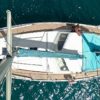5 steps to take when waiting for weather
As we sit on our hands in Martinique, waiting for a bit of moderation before we head off on our next passage south, I mentally review the checklist of tasks that allow us to leave when presented with a weather window:
- 1. Monitor the weather closely.
Good weather info is easy to come by these days. Most boats have some way of accessing the internet and as such, can draw information from a variety of excellent sources*. In addition to that, some boats use their SSB radios to tune into reports made by marine weather forecasters while others download grib files via their satellite phones. Regardless of which method(s) you use, track the weather closely so that you can plan ahead to know when you might be able to leave port.
- 2. Ensure that the boat is sufficiently stocked with fuel and water.
The last thing you want to be doing on your scheduled departure day is trying to top up your tanks at a fuel dock. Considering that you are likely not the only vessel waiting for a weather window, there is a good chance that if you fail to heed this advice, you might end up stuck behind another boat taking on hundreds of gallons of diesel. Top up your tanks early and there will be one less thing to worry about come departure day.
- 3. Have on board sufficient provisions for the passage.
While a 15nm inter-island passage may not require the same type of provisioning that an ocean crossing does, no one wants to leave port without food on board. If you’re in a spot with good shopping, take advantage of those opportunities early by stocking your boat with whatever food and drink products that you enjoy. Then when it comes time to leave, you won’t feel tempted to make a last minute trip to the store.
- 4. Test in advance all necessary systems to ensure that they are functioning.
Engines running properly? Check. Oil and filters changed? Check. Rigging and sails in good shape? Check. Making repairs when you should be sailing out of the harbor during that tiny weather window is definitely not what you want to be doing. How do we know this? By experience, of course. Just moments before our scheduled early-morning departure from Bequia where we had planned a 2 day passage to St. Martin, we were surprised to find that the navigation lights on our bow were not working. It took only a bit of troubleshooting to find that the problem was a burnt out light bulb and fortunately, we had a spare on board. If we had not, the hour long delay might have caused us to miss an entire day, or more. If possible, check all of your systems days prior to the date you hope to depart.
- 5. Monitor the weather closely.
Yes, I did mention this at the beginning of this piece but it bears repeating. Weather conditions can change radically from day to day (or even hour to hour) as forecasters are given new information on which to base their predictions. If you have completed all of the above, you will be able to set sail earlier than you might have initially anticipated should the forecast improve. Plan ahead and you can take advantage of such an opportunity.

Get your work done early and you can relax with your friends while waiting for that weather window.
Photo courtesy of Chuck and Barb on Tusen Takk II.
*Weather Links:
- Passage Weather – We use data from this for passage planning.
- Wind Guru – We use data from this for passage planning.
- Caribbean Hurricane Network
- National Hurricane Center – We check this at least daily during H season.
- Wind Finder
- Weather Underground – We use this for local weather.
- Weather Underground – Tropical – We check this for tropical storm tracks, etc..
- Crown Weather
- Tide Forecast
- Intellicast – Nice site if you have the bandwidth.



How do you decide which forecaster to believe?
Mike
We make our own decisions based after consulting multiple sources, never just one.
Every boater should take a weather course – learn to read the sky, understand what his barometer is telling him. Look at satellite images of front movement for several days before starting a long passage. Don’t believe NOAA. Ever.
And listen to Chris Parker. There’s a man who knows where to get the information and how to interpret it. He errs on the side of caution, if he errs at all.
I agree about not taking NOAA as gospel, or any other source for that matter. I have friends who are Chris Parker subscribers and you’re right, he is accurate most of the time, especially in the Bahamas.
Gess the guy in the grey beard and black hat must have seen a mermaid recently…..
🙂
I thought that looked funny too.
I’m just saying John likes his noodle!!
What guy doesn’t?